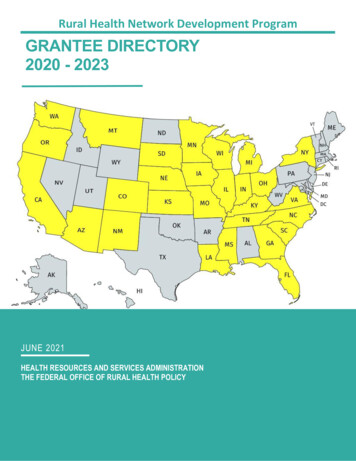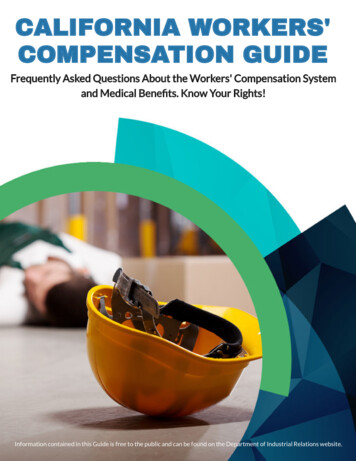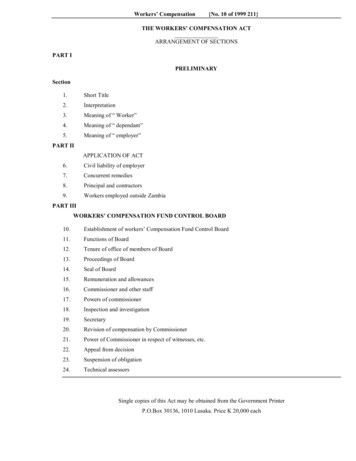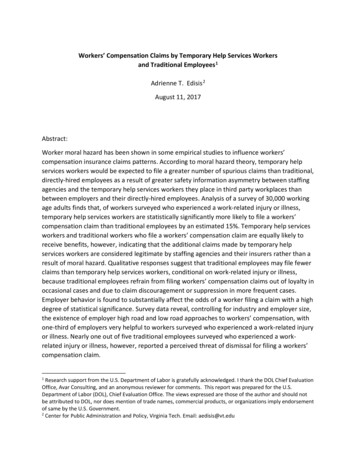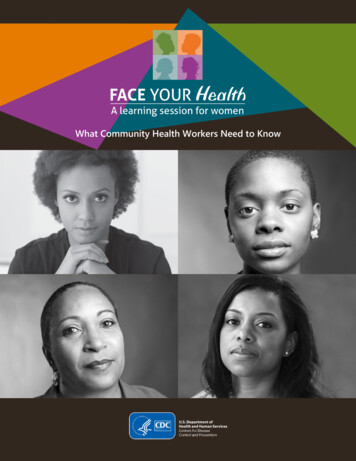
Transcription
1What Community Health Workers Need to Know
2WELCOME!Thank you for your interest in Face Your Health, aneducational outreach program to encourage AfricanAmerican women to get screened for cervical cancer. FaceYour Health was developed by the Division of CancerPrevention and Control at the Centers for Disease Controland Prevention (CDC). It was adapted from a similarprogram that has proven effective in promoting cervicalcancer screening among Hispanic women. A group ofexperienced African American community health workersand program administrators from rural and urban settingsacross the United States provided guidance and input onthe development of Face Your Health.Face Your Health learning sessions help teach women howthey can prevent cervical cancer, why regular screening isso important, and where they can get screened. If you arean outreach worker, case worker, or community healthworker interested in delivering Face Your Health learningsessions in your community, this guide is for you. Itprovides an overview of the program, including how to getstarted, how a learning session is conducted, andstrategies for following up with participants. Use this guideand the accompanying resources and materials to deliversessions to the women in your community.Thank you for helping women make positivechanges for their health!
3TABLE OF CONTENTS4An Introduction to Face Your Health9Get Started14Conduct a Learning Session18Follow Up and Track ProgressA23APPENDIX A Pre-Learning Session ChecklistB24APPENDIX B Post-Learning Session ChecklistC25APPENDIX C Sample Learning Session RecordD26APPENDIX D Safety Tips for Home Visits
4AN INTRODUCTION TOFACE YOUR HEALTHIN THIS SECTIONLearn the basics about theFace Your Health program: Who it’s for. Why it’s important. What information women should learnfrom the program. What the components of the program are.
5WHAT IS FACE YOUR HEALTH?Face Your Health is an educational outreach program to help community health workers (CHW) and other layhealth educators promote cervical cancer screening among African American women who are 21 to 65 yearsold. The program is important because: African American and Hispanic women are more likely to develop cervical cancer than other women in theUnited States.1 African American women are more likely to die from cervical cancer than other women.1 Many women do not understand why they need screening, when they should be screened, and how theycan be screened.2 Many African American women also face situations that make it harder for them to get screened, such aslack of insurance coverage or access to a regular healthcare provider or clinic.3CHWs use the Face Your Health lesson plan and flip chart to deliver short, interactive learning sessions one-onone or in groups. The learning sessions are designed to help women: Understand that African American women are at greater risk than other women of dying fromcervical cancer. Learn that most cervical cancer is caused by human papillomavirus (HPV). Understand what cervical cancer screening is and how often they should get screened. Find out where and how to get screened. Make a promise to themselves to get screened, and to keep getting screened every 3 or 5 years.1U.S.Cancer Statistics Working Group. U.S. Cancer Statistics Data Visualizations Tool, based on 2019 submission data (1999–2017): U.S.Department of Health and Human Services, Centers for Disease Control and Prevention and National Cancer Institute;www.cdc.gov/cancer/dataviz, June 2020.2HawkinsNA, Benard VB, Greek A, Roland KB, Manninen D, Saraiya M. Patient knowledge and beliefs as barriers to extending cervicalcancer screening intervals in Federally Qualified Health Centers. Prev Med 2013;57(5):641–5.3PetersonNB, Murff HJ, Cui Y, Hargreaves M, Fowke JH. Papanicolaou testing among women in the southern United States. J WomensHealth 2008;17(6):939–46.
6outreach educatorpeer healtheducatorfamilysupportworkerpromotorade saludlay health workeroutreachworkerpeer health promoterlay healthadvocatecommunity volunteercommunity health advisorcommunity health representativeCommunity health workers can go by many titles. Here are some of them.Who are community healthworkers?CHWs are frontline public healthworkers who understand theculture of their community. CHWsserve as liaisons between healthand social services and thecommunity. They help people inthe community access services andincrease their health knowledgeand self-sufficiency. They also helpimprove the quality of localservices to meet the cultural needsof their community.WHAT SHOULD WOMEN LEARN?As a CHW, your main goal is to encourage women who attend a learning session to get screened for cervicalcancer. After attending a learning session, we want women to know: African American women are more likely than other women to die from cervical cancer. Getting screened for cervical cancer can help them stay healthy. They can get free or low-cost cervical cancer screening in their community. One screening is not enough—they need to get screened every 3 or 5 years.After attending a learning session, we want women to feel:Important to themselves, their families, and their community.Empowered to ask questions, seek knowledge, and use whatthey’ve learned to stay healthy.Supported to know there are people and resources in theircommunity ready to help.Resourceful to find ways to overcome challenges and get whatthey need to take care of themselves.
7WHAT SHOULD I KNOW ABOUT FACE YOUR HEALTH?Face Your Health was designed with both you and the women your organization serves in mind. The program is: Community-oriented. It was developed with input from researchers and experts in the CHW field wholive and work in communities like yours. It was designed to be delivered by CHWs and other lay healtheducators in a variety of settings.4 Audience-friendly. The learning session and materials are easy to follow and understand. They use visualaids to engage women with different reading levels and health knowledge. Effective. The program is rooted in the latest science and practices and uses methods proven to increasecervical cancer screening. It’s based on a program that was shown to increase Pap test use by Hispanicwomen in a scientific study.5 Interactive. Games and other activities help review and reinforce information, promote discussion, andaddress concerns. Easy to use. It can be integrated easily into the outreach work you’re already doing. The lesson plan guidesyour sessions and prepares you to answer questions. Materials can be customized and printed in black andwhite or color from a desktop printer.You have flexibility in the way you deliver the program. You can give a learning session: To 1 woman or to a group of as many as 15. In less than an hour or up to 2 hours for the full, interactive experience. In a woman’s home, in a clinic or other health care setting, or in a community setting such as a place ofworship, library, or community center. On its own or combined with another health topic important to the women you serve.Smith JL, Wilson KM, Orians CE, Byrd TL. AMIGAS: building a cervical cancer screening intervention for public health practice. J Womens Health2013;22(9):718–23.45ByrdTL, Wilson KM, Smith JL, Coronado G, Vernon SW, Fernandez-Esquer ME, et al. AMIGAS: a multicity, multicomponent cervicalcancer prevention trial among Mexican American women. Cancer 2013;119(7):1365–72.
8WHAT RESOURCES ARE AVAILABLE?A full set of resources will help you prepare for and present a learning session, including tools and strategiesyou can use to support women in their decision-making process to get screened.ITEMWHAT IT ISHOW IT’S USEDFace Your Health: WhatCommunity HealthWorkers Need to KnowGuide that provides CHWs with steps and tips for delivering General reference and traininga Face Your Health program, including preparing for,conducting, and following up after a learning sessionJob AidsTools such as checklists and tip sheets: Pre-Learning Session Checklist Post-Learning Session Checklist Learning Session Record Safety tips for home visitsSupport the day-to-day workof CHWsPromotional MaterialsPosters and social media images to promote Face YourHealth and the importance of cervical cancer screeningPrinted or shared on websitesand social media sitesLesson PlanScript/talking points to guide CHWs through conducting asession and delivering the flip chartTraining and delivery of alearning sessionFlip ChartCore educational content of the program used to guideindividual and group sessionsTraining and delivery of alearning sessionGamesInteractive games to build rapport, facilitateTraining and delivery of acommunication, reinforce lessons, and address barriers:learning session Face the Facts, a test-your-knowledge game aboutcervical cancer Face Yourself, a game to discuss common challenges togetting screened for cervical cancerFollow-up FormsData collection forms:Distributed by CHWs for Contact Sheet with participant information and space to women to complete after asessionlog followup Evaluation Form to document feedback fromparticipantsTake-home MaterialsInformational handouts for participants: Promise Sheet (signed pledge to get screened) Appointment Sheet Fact Sheet Resource Sheet with information on local clinics thatoffer screeningDistributed by CHWs forwomen to keep after a sessionQuick Reference GuideA glossary of medical terms related to female health andcervical cancer, along with answers to questions notcovered in the flip chart or lesson planGeneral reference and training,and to supplement a learningsession
9GET STARTEDIN THIS SECTIONLearn how to prepare for a Face Your Healthlearning session by following these steps: Practice the session. Schedule the session. Promote the session. Confirm the session.
10Follow these step-by-step instructions to get ready for your Face Your Health learning session. Use the PreLearning Session Checklist to keep track of what you need to do and when to do it; see Appendix A.STEP 1: PRACTICE THE SESSION Start by reviewing the latest information about cervicalcancer. Be familiar with what causes it, what puts women atrisk, and what the current screening guidelines andrecommendations are. The Face Your Health lesson planincludes the basic information you need when conducting alearning session and answering questions from participants.Find more information about cervical cancer on CDC’s websiteat www.cdc.gov/cancer/cervical/. Get familiar with the medical terms and how to pronouncethem. The Quick Reference Guide includes a glossary of termsto know.TIP: Be sure to attend any trainingsyour program administrator orsupervisor organizes. Even if you’realready familiar with the topic or ifyou’ve conducted similar educationalsessions, it’s important to know howto use the Face Your Healthresources. Trainings can also helpyou stay up-to-date on screeningguidelines and recommendations. Be prepared to discuss disparities African American women face with cervical cancer. The most importantmessage is that African American women are more likely to die from cervical cancer than other women, butwith regular screening, cervical cancer can be prevented or caught early and treated. You may want toreview current statistics and trends on cervical cancer so you’re ready to answer more detailed questionswomen may have. The Data Visualizations tool has up-to-date information for the country as a whole andfor individual states and counties at www.cdc.gov/cancer/dataviz. Get comfortable with the content and flow of the learning session. The lesson plan lays out a suggestedscript and talking points, including how to prompt participants to generate group discussion. It includesinstructions for how and when to play the games, which take-home materials to hand out, and how to usethose materials to help women take the next step toward screening. Have a plan for responding to women with sensitive questions or concerns, such as sexual abuse ortrauma. The Quick Reference Guide offers tips and talking points for some scenarios. Your familiarity withthe needs and experiences of the women in your community will help you anticipate sensitive topics thatmay come up. Practice delivering the session out loud using the flip chart until you no longer need to refer to the script. Ifyou can, practice with another CHW or group of CHWs. Role playing can help you prepare to answerquestions, handle challenging scenarios, and incorporate interactive elements like the games.
11STEP 2: SCHEDULE THE SESSIONIf your organization has already decided where to offer Face Your Health sessions, you should follow thoseinstructions. However, if you are deciding the best way to deliver sessions in your community, here are thingsto think about.Group SessionsLook for places that are: Convenient, so women can get there easily and quickly by car or public transportation. Comfortable, so there’s enough seating and room to stand up and moving around. Private (or semi-private), so only women in the group can hear what is being discussed.If your organization doesn’t have a room that will work, meeting rooms in a local place of worship, library,school, health clinic, or community center are good options. Reserve the location at least 2 to 4 weeks inadvance so you have time to recruit for and promote the learning session.Schedule the session for a time of day you think will work for women in your community.Some programs offer small gifts like notepads, pens, or cups at the end of a learning session. If you’re planningto do this, decide what gifts would be appropriate. How many will you need and how will you get them?One-on-One Sessions Individual visits are better for talking about a woman’s own experiences and concerns, especially if she hashad a past trauma or is concerned about privacy. Some women may like you to come to their home, especially if they don’t have childcare. If you’reconducting a session in a woman’s home, try to schedule it during the day. Follow your organization’ssafety tips for conducting home visits, or see Appendix D. If you’re doing a home visit and other women in the house want to participate—the woman’s mother,friend, or daughter, for example—you can adapt the session for a group using the lesson plan and games.
12STEP 3: PROMOTE THE SESSIONIf your organization has procedures for recruiting women to attend health education sessions, you shouldfollow them to recruit participants for Face Your Health. If not, here are some suggestions: Recruit participants through local organizations that also servethe women you want to reach. You can also invite women youare working with another program, or ask women you know toinvite their friends or family members. Print and hang Face Your Health posters in places where womenare likely to see them. Ask local grocery stores, churches,community centers, schools, childcare centers, and other locationsabout putting up posters. If your organization has a website or uses social media, postinformation about the sessions and invite women to call or sign uponline. Ask local partner organizations if they will promote thesessions on their web and social media sites. Whatever method you use to recruit, try to make a personal call orsend an email to invite women to the session. They will appreciatethe personal touch.TIP: When advertising orpromoting a Face Your Healthlearning session, focus on aspectsthat will generate interest andenthusiasm. Here are some waysto describe what women canexpect from a session:Learn how to stay healthy.Learn and share informationabout cervical cancer screening.Talk about things that may helpother women you care about.Socialize and meet otherwomen in the community.Have a good time!Getting the Most Out of Your Promotional ActivitiesHere are some ideas to make your promotion more visible and help get more people interested in yourlearning sessions: Schedule sessions during Cervical Cancer Awareness Month in January. Take advantage of promotionalactivities around cervical cancer in the news, on social media, and in other outlets to generate interest inyour community. Consider the season and link Face Your Health to themes like “new year, new you.” If your organization participates in other health observances, screening campaigns, educational sessions, orhealth fairs, look for opportunities to cross-promote with Face Your Health. Raise awareness throughout the year by incorporating key facts about cervical cancer and screeningreminders into your organization’s regular promotional activities, such as social media posts, websitefeatures, community newsletters, texting services, and other communications. When asking partners to share your messages and announcements, make it convenient for them. Givethem prepared text or images to use. Hang up or hand out the Face Your Health posters to promote your learning sessions. There are fourposters, each featuring a different woman across the 21 to 65 age range. Select the posters that willresonate best with the women you’re trying to reach. There’s a section for you to add information like yourorganization’s phone number or website, or the date and time of the next learning session.
13STEP 4: CONFIRM THE SESSIONConfirm the session 1 to 2 days in advance. For an individual session, call, email, or text the woman to remind her. Reschedule if she says she can’t bethere. Get or give directions to where you will meet, if necessary. For a group session, confirm the meeting space for your session is still available. Post reminders about thesession on any web or social media sites you’ve used to promote it. Call, email, or text any women you canto remind them to attend.
14CONDUCT A LEARNING SESSIONIN THIS SECTIONGet an overview of what’s involved in alearning session: Preparing for the session. Conducting the session.Details on how to conduct a session from start tofinish—including a script to help you discuss thekey topics—are in the Face Your Health lesson plan.
15This section describes the learning session—preparing for it, its basic content, and how it fits into the overallFace Your Health program, which includes following up with participants and evaluating your progress. TheFace Your Health lesson plan provides a script to help you discuss the key topics, detailed instructions for usingthe flip chart, and games to conduct. It also includes instructions for using the handouts and other materials toencourage women to make cervical cancer screening appointments.PREPARE FOR THE SESSION1 to 2 Days Before the Session Review your lesson plan. Practice saying the talking points on the back of the flip chart and prepare anymaterials or props you’ll need for the games. Make confirmation calls or send emails. If you’re conducting a home visit, call the woman’s home to makesure she’s expecting you. If you’re conducting a group session, confirm your reservation with the facilityand make sure the room and equipment will be ready. Call or email your learning session participants toconfirm they are coming. Make copies of the items you’ll need to take with you.Here are the items you’ll need: One double-sided copy of the flip chart to display and read from as you work through the session. A copy of the instructions for each game and any scripts or information sheets. Enough copies of these handouts for each woman to take home: Promise Sheet, Resource Sheet,Appointment Sheet, and Fact Sheet. Enough copies of these forms for each woman to complete and give back to you: Contact Sheet andEvaluation Form. A copy of the Quick Reference Guide, in case questions come up during the session that are hardto answer. If you are offering small gifts, make sure you have enough for the number of participants you’reexpecting. If your organization has funds available, consider bringing water or tea and healthy snacks tothe session.Day of the Session Gather your session materials, any gifts you’re providing, and any drinks or snacks you’re serving. If you’re conducting the session as a home visit, make sure you have directions and some informationabout the neighborhood (for example, where you can park). Leave plenty of time to get there. If you’re conducting a group session, get there as early as you can to set up the room.
16CONDUCT THE SESSION The main component of the learning session is the flip chart. This series of 8.5- by 11-inch sheets hasgraphics and minimal text on the front of each sheet to help women follow along while you deliver thecontent. Talking points are on the back of each flip chart sheet, and the full script is in the lesson plan. The learning session is designed to be interactive and encourage participation and discussion. Thelesson plan recommends starting with an icebreaker to help women get comfortable with one another,and with you. Prompts are included throughout to remind you to ask questions that help spark sharingand discussion. Two games are incorporated at specific points in the session to test women’s knowledge and reinforceimportant messages. Games can be skipped if you have limited time, or if your audience prefers not toparticipate. Information that most women need to know about cervical cancer and screening is the focus of thelesson plan and flip chart. The Quick Reference Guide prepares you for scenarios that may affect asmaller number of women—such as HPV vaccine or sensitive topics like sexual assault—so you’re readyto address them if they arise. The learning session also gives you an opportunity to educate women about basic female anatomy andwhat happens during a cervical cancer screening test. This information may be especially important forwomen who have never been screened before. You may cover this information in more or less detail,depending on how much time you have and participants’ level of knowledge. Toward the end of the session, you’ll hand out materialswomen can take home to reinforce what they learned andserve as reminders to make an appointment and getscreened regularly. One of these items is a Promise Sheet. Itencourages them to sign a pledge to get screened and set atarget date to do it. Research shows that this type of activitymay make women more likely to follow through on screening.The Promise Sheet encourages women to treat themselves tosomething special as a reward for keeping their pledge. You’ll also ask the women to complete a Contact Sheet—which you can use to record your follow-up conversations andtrack their progress—and an Evaluation Form providingfeedback on their experience with the session. Yourorganization can use these to see how well the sessions are working.TIP: The flip chart slides “TheFemale Reproductive System” and“How Do You Get Screened forCervical Cancer?” are visual aidsshowing the basic female anatomyand a diagram of a pelvic exam,respectively. You can pull these outand use separately for this or othereducational opportunities, or hangthem up in the office or clinic touse as routine teaching tools. The session can be done in as little as 30 to 45 minutes, for one-on-one sessions or group sessionsconducted without the games. The full group experience—completing the flip chart, playing bothgames, and leaving ample time after the session for feedback and discussion—can take more thanan hour.
17General Tips for a Successful Session Be friendly. Introduce yourself and make small talk before you start. Encourage women to ask questions and share their stories. For a group session, try to get every woman totalk at least once. Be sure to stress that the sessions are confidential. Talk slowly and make eye contact with the women when you are reading the flip chart. Make sure everyone can see the flip chart. Make the games fun! No one should be embarrassed not to know an answer.Face Your Health Flip Chart Components What Is Cervical Cancer? The Female Reproductive System What Have You Heard About Cervical Cancer? What Causes Cervical Cancer? Who Can Develop Cervical Cancer? Why Do You Need to Get Screened for Cervical Cancer? How Do You Get Screened for Cervical Cancer? How Often Should You Get Screened for Cervical Cancer? What Do Your Test Results Mean? What Can You Do to Prevent Cervical Cancer? What Makes It Hard to Get Screened? What Should You Do Next? How Should You Prepare for Your Screening Test?
18FOLLOW UP AND TRACK PROGRESSIN THIS SECTIONFind out what you should do to keep trackof participants: Right after the session. 1 to 2 days after the session. 1 to 2 weeks after the session. 1 month after the session.
19The learning doesn’t end after the session is over—for you or your participants. It’s important to follow up withwomen multiple times (if possible) during the days and weeks after the session to support their progress,answer their questions, and reinforce the importance of screening and other educational messages. Talking towomen after the session will also help you learn what information resonates with them and what challengesthey’re having so you can tailor future sessions to meet their needs better. Use the Post-Learning SessionChecklist to keep track of everything you need to do after each session.RIGHT AFTER THE SESSION1. Complete the Learning Session Record to track where and when you delivered the sessions, the number ofwomen who attended, and your overall experiences. Keeping track of this information is important forseveral reasons: It helps you learn how to make your sessions better. It helps you keep up with your work and show your supervisors what you’ve done. It keeps track of your progress in helping women get screened. It helps administrators make the program better and get better health services for women. It gives your administrators information they can use to show how well the sessions are going andgather more support for the program.See Appendix C for an example of a completed Learning Session Record.2. Collect the Contact Sheets from session participants. On each sheet, record the date and location of thesession and if you were able to schedule a screening appointment at that time. You will fill in the rest of theform after you follow up with each woman. See the Face Your Health lesson plan for an example of acompleted Contact Sheet and instructions for using it during a learning session.3. Turn in copies of the Contact Sheets and Evaluation Forms, and the Learning Session Record to yourprogram administrator or supervisor (if required). If you had any problems with your session, schedule timeto discuss them with your administrator or supervisor.
201 TO 2 DAYS AFTER THE SESSIONUse the Contact Sheets to follow up with the women. Following up is important because it: Helps you learn if the sessions are encouraging women to get screened. Gives you a chance to offer extra encouragement and support to women who are still not sure aboutbeing screened. Helps you learn if women are able to make their screening appointments and, if not, how you canhelp them. Lets you talk one-on-one and address any personal or sensitive questions they might have.If your organization already has forms and procedures for conducting follow-up calls, you should use those. Ifnot, follow the steps below.1. Review the Contact Sheets. Call each woman to thank her for talking with you and to congratulate her fortaking charge of her health. Ask each woman: If she has an appointment to get screened. If she does, ask if she has any questions. Remind her how toprepare for the appointment. If she would like any help making an appointment to get screened. If she has any questions or needs more information about getting screened. Make sure she knows howto contact you or someone else in your organization when she’s ready to make an appointment.2. Record notes from your conversation in the follow-up section of the Contact Sheet. If you schedule anappointment, note the date and location. If a woman is not ready to make an appointment, note herreasons so you can tailor future conversations to address the specific barriers she is facing.
211 TO 2 WEEKS AFTER THE SESSION1. Review the Contact Sheets and call each woman to check on her progress toward getting screened.2. If an appointment is not scheduled on her Contact Sheet, ask if she needs help making one. If she is notready, ask what her concerns are and if you can follow up with her in another month.3. If an appointment is scheduled on her Contact Sheet, congratulate her for taking the next step! Confirm the date, time, and location of the appointment. Remind her how to prepare for the appointment. Ask if she has any questions you can answer.4. If an appointment has been completed: Ask her how the appointment went, which tests she had done (Pap, HPV, or both), and when sheexpects her results. Remind her how important it is to follow up with the clinic about her results. Encourage her to contactyou if she has any questions when her results come back. Remind her how important it is for her to get screened again in 3 or 5 years. Suggest she add areminder to her calendar or phone. Brainstorm other ways to help her remember to get screened every3 or 5 years. If necessary, review the screening options with her. Ask if she has any questions you can answer.5. Record notes from your conversation in the follow-up section of the Contact Sheet. If you schedule anappointment, note the date and location of the appointment. If a woman is not ready to make anappointment, be sure to note her reasons.1 MONTH AFTER THE SESSION1. Review the Contact Sheets and follow up with all women who were planning to or scheduled to getscreened since your last call.2. If a woman does not have an appointment, ask if you can help her make one.3. If a woman has been screened, ask if she has her results and if she has any questions about them. If she wastold to come back for a follow-up appointment, ask if she has scheduled
Find out where and how to get screened. Make a promise to themselves to get screened, and to keep getting screened every 3 or 5 years. _ 1. U.S. Cancer Statistics Working Group. U.S. Cancer Statistics Data Visualizations Tool, based on 2019 submission data (1999-2017): U.S.
